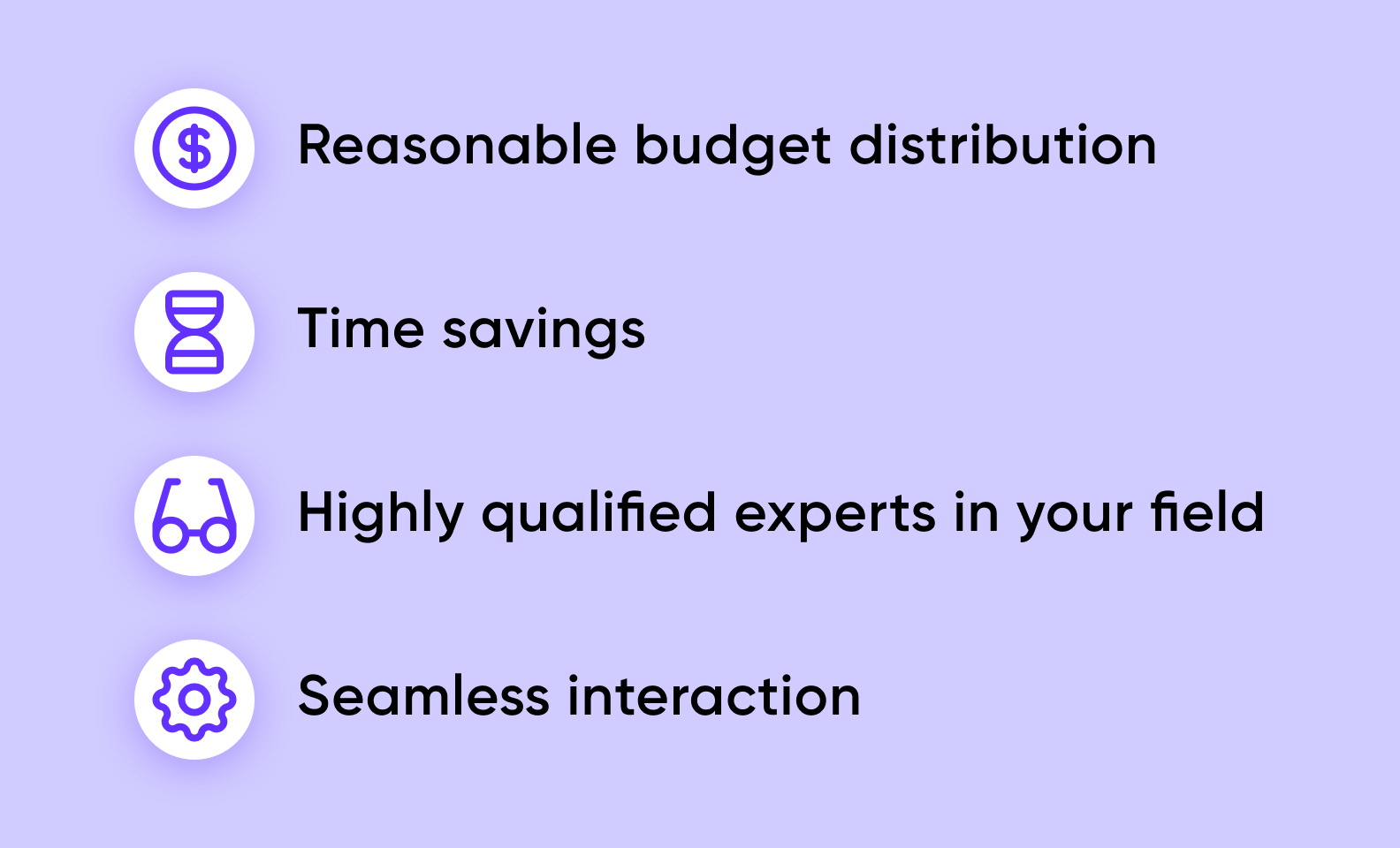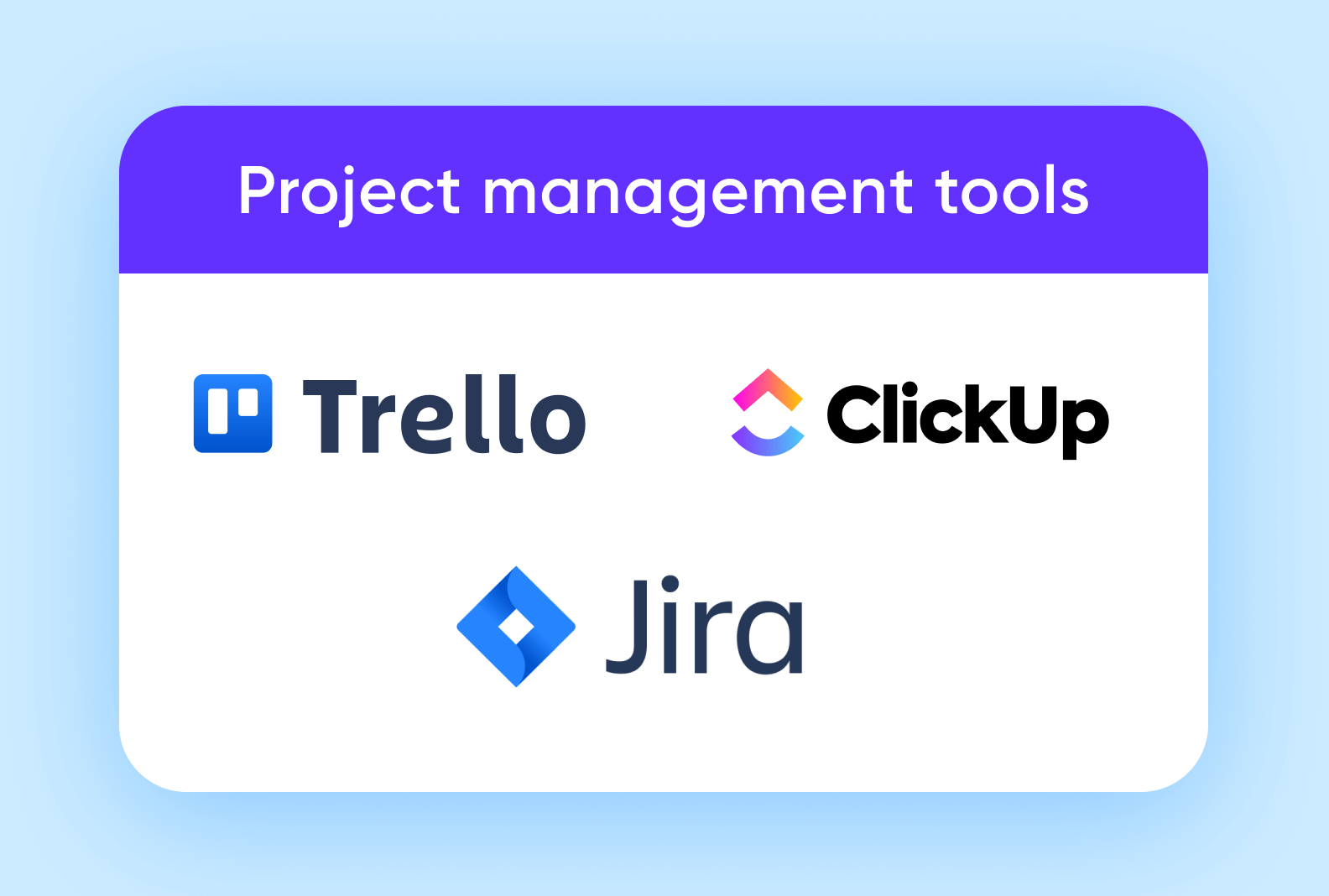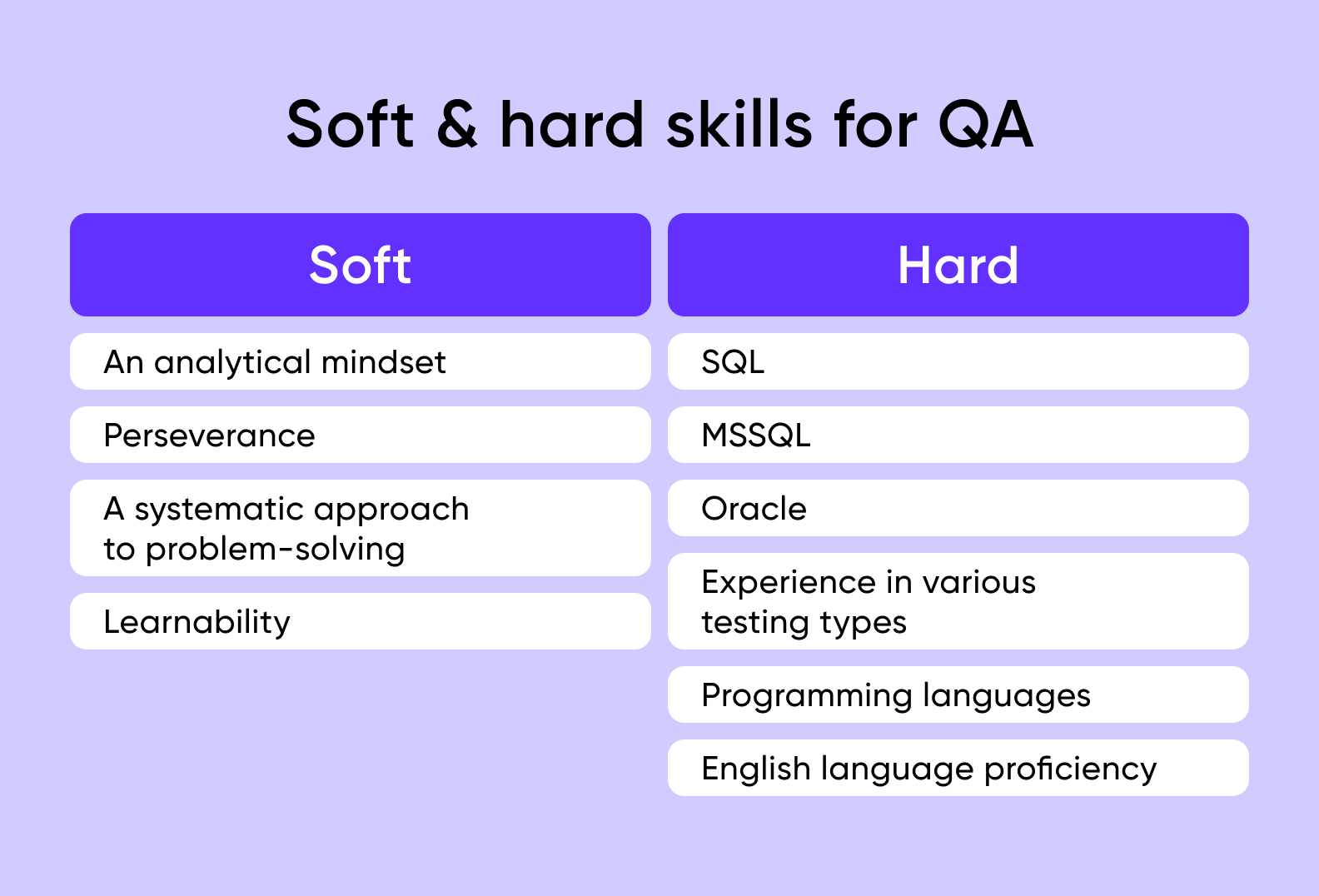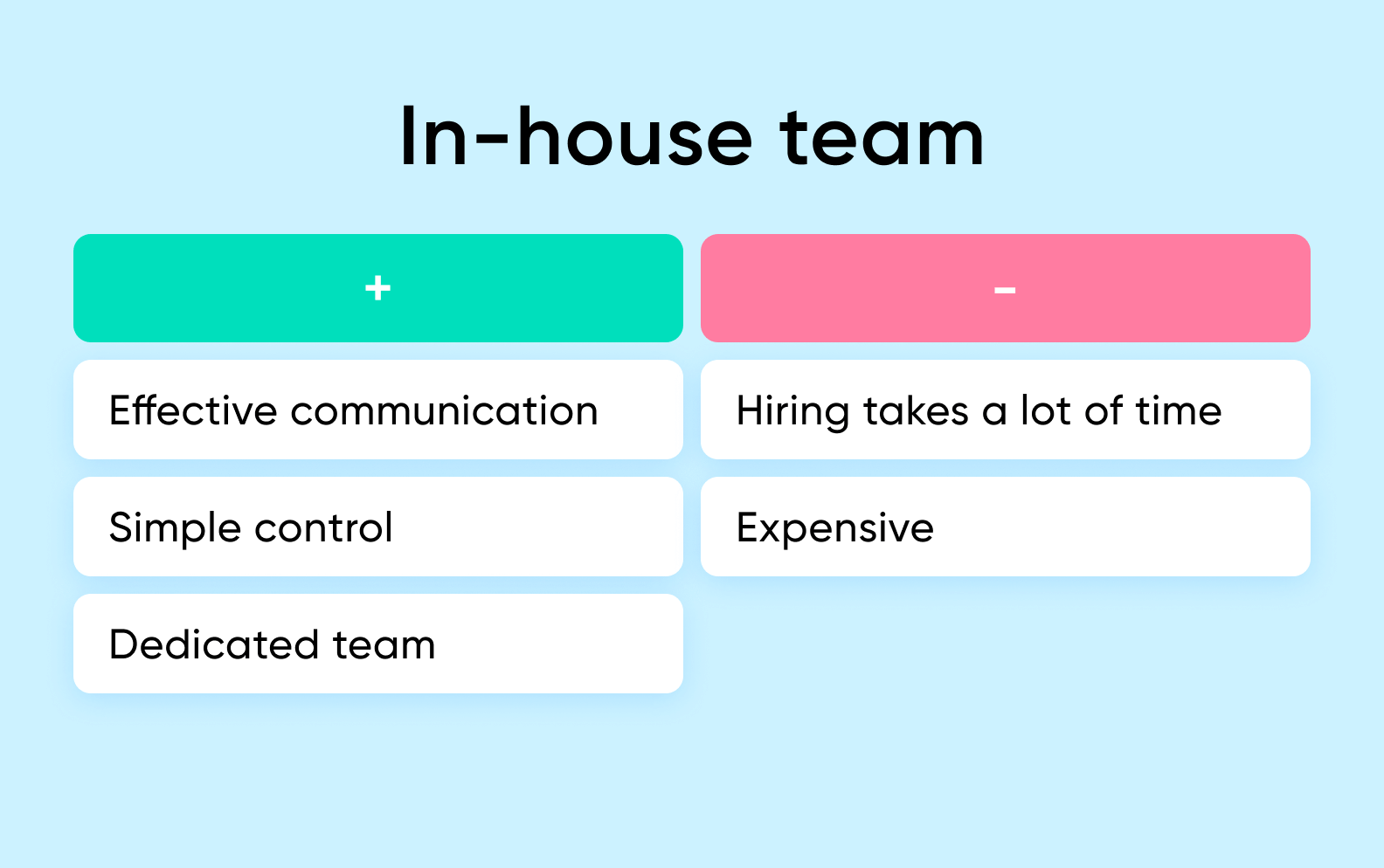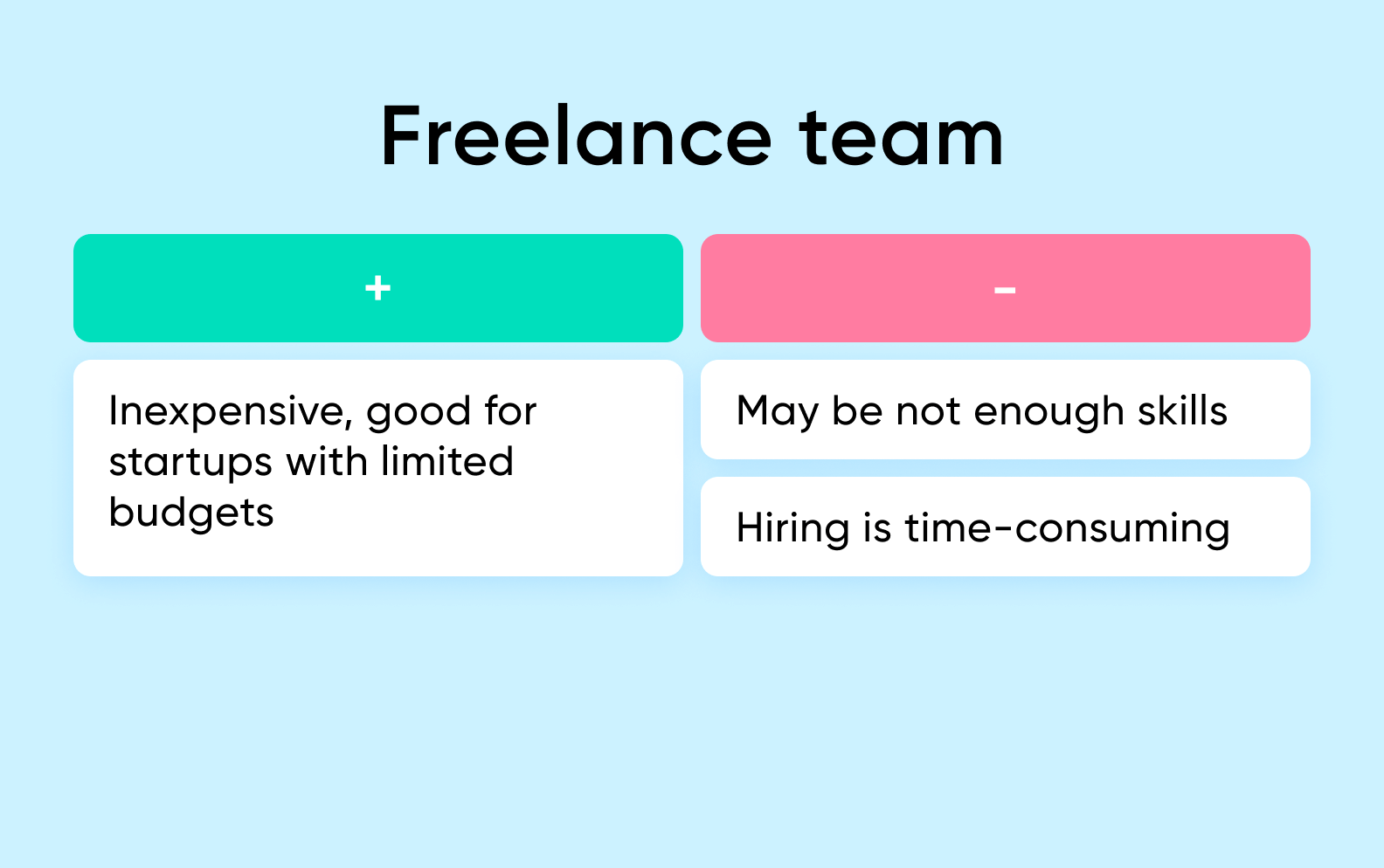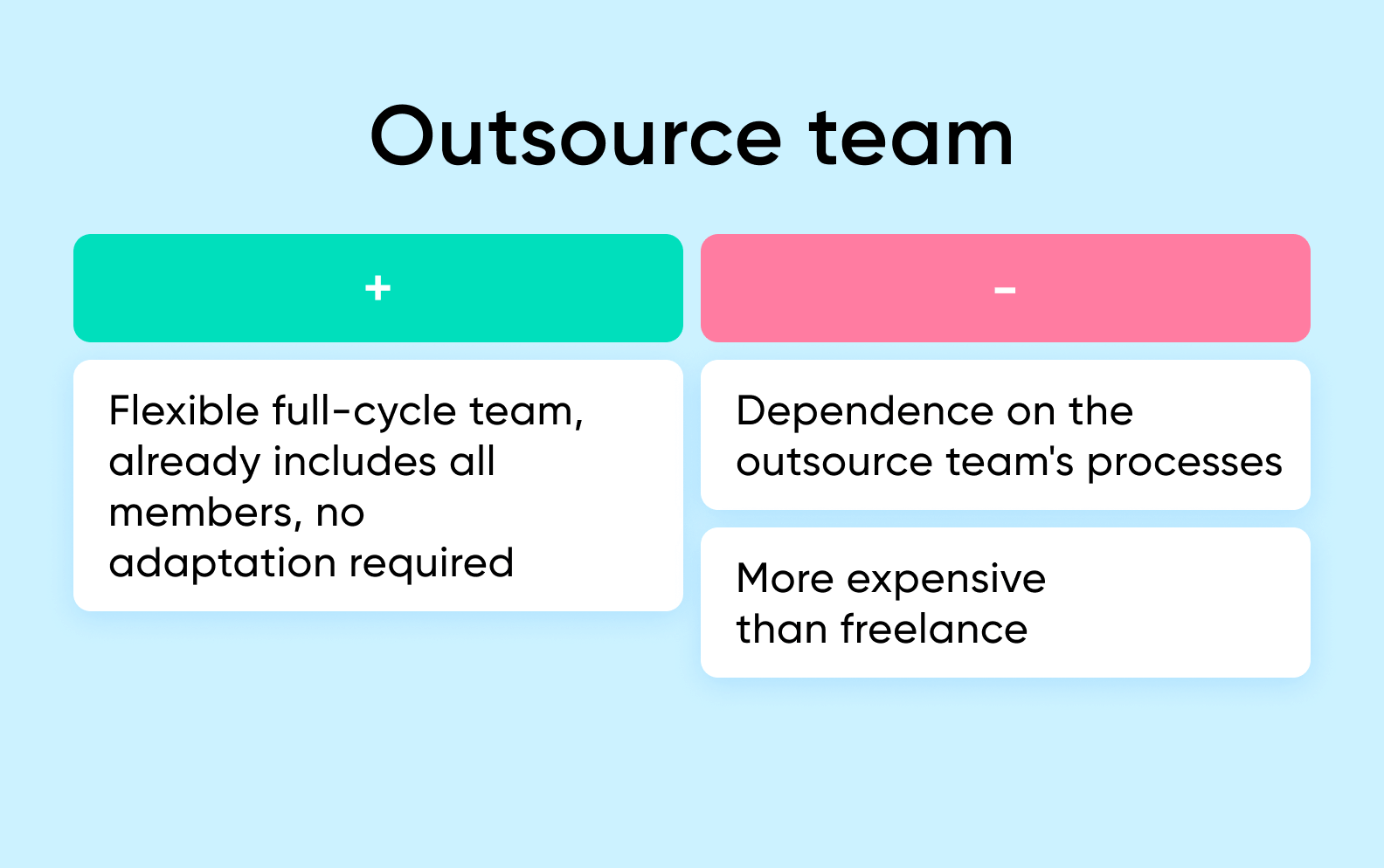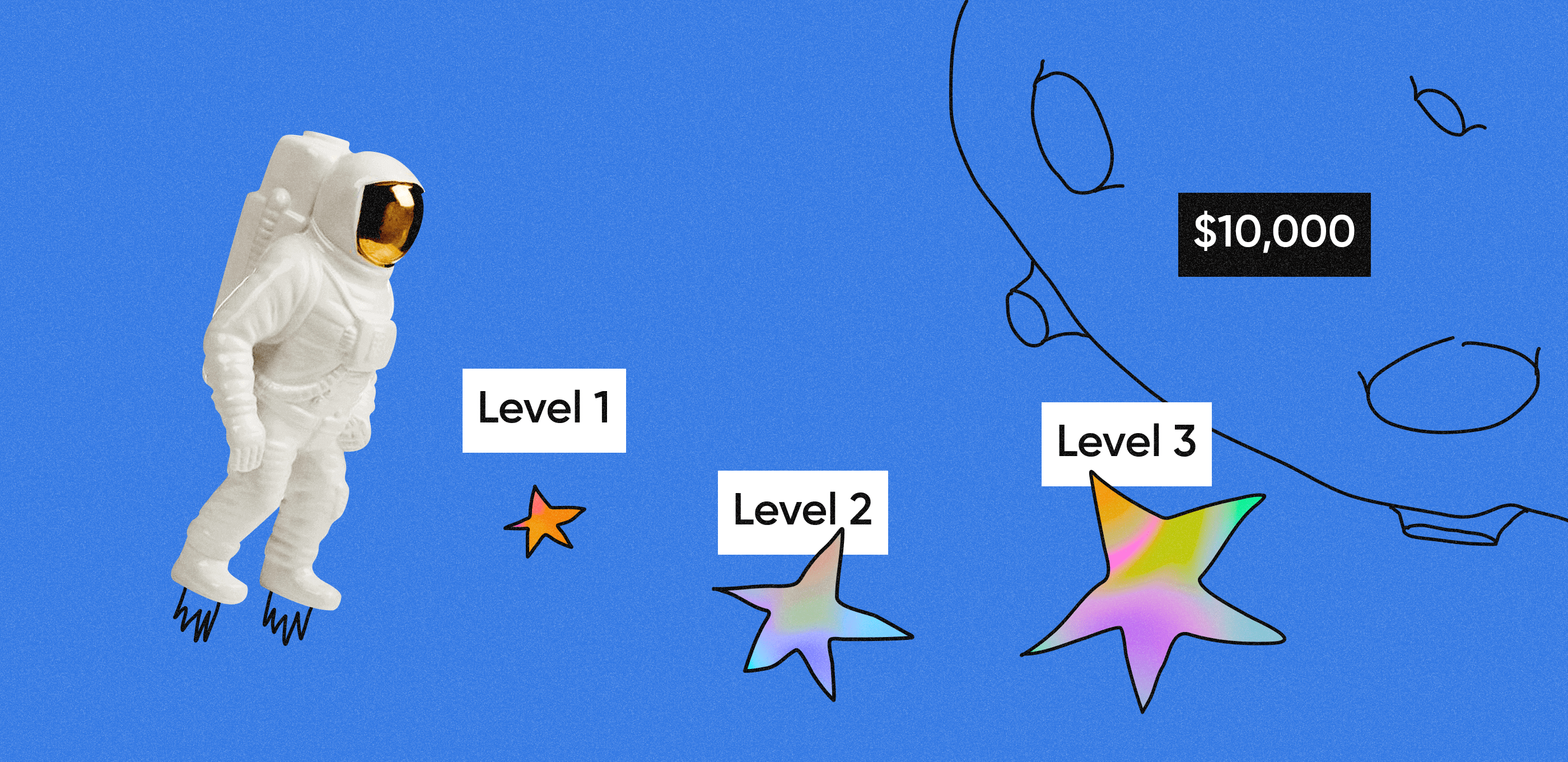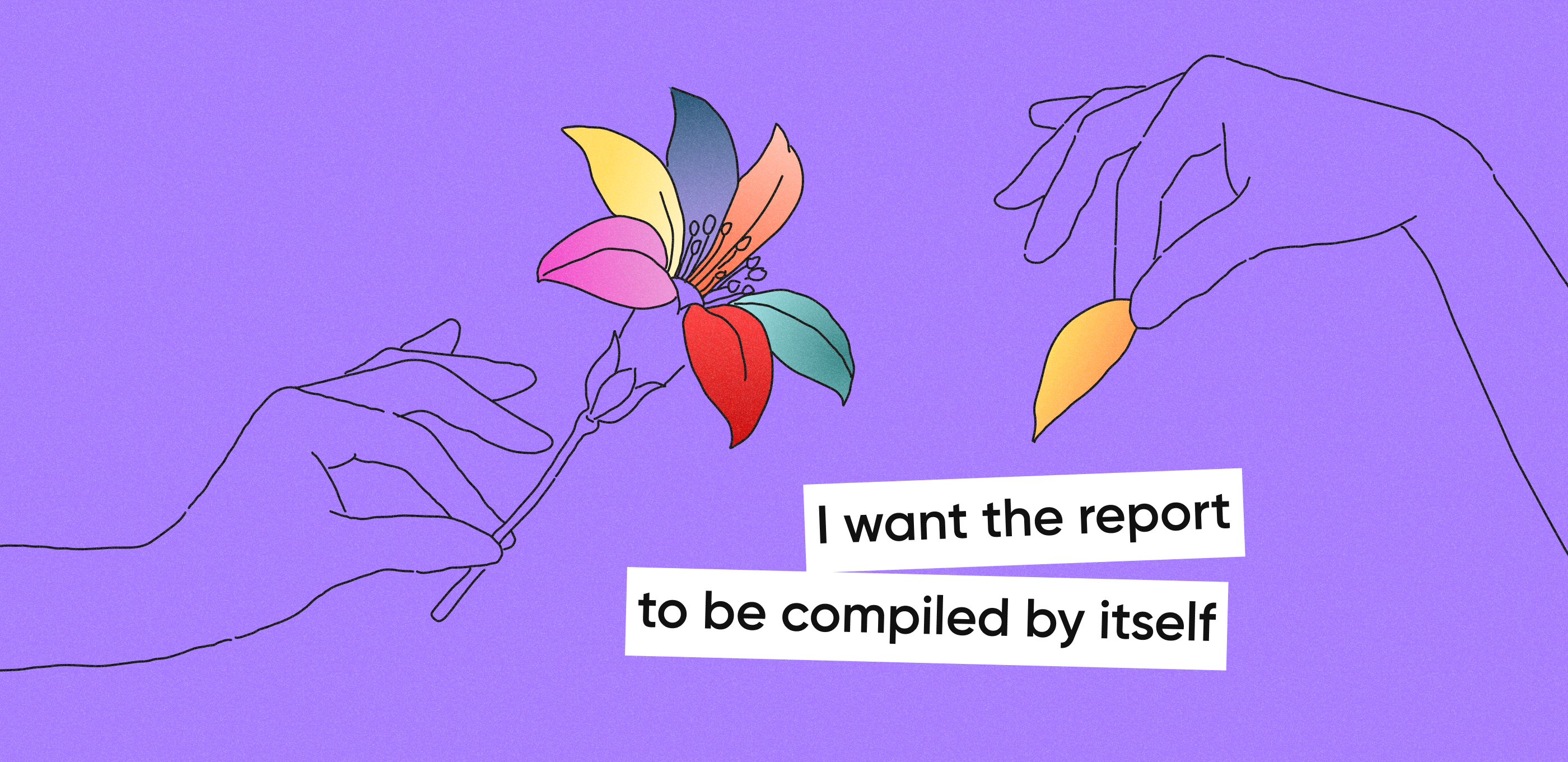Key takeaways
-
- A typical mobile app development team includes a business analyst, a system analyst, a project manager, UI/UX designers, frontend and backend developers, QA engineers, and a team lead.
- The best way to find a development team is to partner with an outsource company: these teams don’t require onboarding and provide high quality at a reasonable cost.
- When searching for a partner, be sure to use different platforms, study reviews, pay special attention to the team’s communication style, and look for the Agile approach.
Why you need a great team and well-organized development process
The golden rule of app development is the better your team, the better your app.
Without segregation of duties, a plan, and consistent work, almost 60% of projects fail— everything could fall apart due to poorly organized teamwork. With a good app development team and seamless development process, you get some extra bonuses.
-
- Reasonable budget distribution. An app development team plans how they create the product and distribute the potential costs accordingly. At the initial stage, specialists will organize your priorities — your money won’t be spent on features and development stages that your product doesn’t need. With the right team, you also reduce the risk of unforeseen expenses: if the development process runs like clockwork, there is little chance that something will go wrong.
- Time savings. A well-established team of mobile app developers with the right resources and skills will be able to develop a product quickly. In the meantime, you can focus on business-oriented and strategic matters, investments, and marketing.
- Highly qualified experts in your field. Each company is unique, but the sphere you are interested in may be larger. For example, it could be healthcare, fintech, or gaming. If you hire experts who specialize in your niche and have enough experience, you can ensure the quality of your future app.
- Seamless interaction. When developers speak your language and know their roles, it will ensure seamless interaction with your team and within it.
Mobile app development team structure
Each person in an IT project plays a crucial role in ensuring the best possible performance. If one of the software development team members is missing, the product will also miss something.
A mobile development team structure typically consists of several people with specific roles and responsibilities. It may vary depending on the size and complexity of the project. As an experienced app development company, Purrweb knows the key to a perfect team structure.
Business analysts
Key duties: responsible for estimation. To complete a project on time and within your budget, you’ll need a timeline and cost estimation. At Purrweb, business analysts are involved in the presales process — they work with clients to understand their needs and complete the estimation based on them.
A business analyst evaluates the whole project — this requires working closely with designers and the whole team of mobile app developers.
System analysts
Key duties: create a single system, connecting “what to do” with “what is done”. A system analyst creates a system based on customer needs, business specifics, design, and technical implementation. This person often acts as a bridge between the startuper and the development team, translating the business requirements into technical specifications. For example, a system analyst helps customers formulate product development terms and helps a team find suitable solutions.
Thanks to system analysts, no one will get confused in business logic. They identify cross-functional interactions, analyze the API (Application Programming Interface), help in designing databases and drafting project documentation. Such a specialist is not always needed, but if the app has complex business logic and a large number of user interactions (like a blockchain app), a system analyst is a real lifesaver.
Project managers
Key duties: responsible for organizing the work process and maintaining regular communication. A project manager is at the core of the app development team structure. PMs set tasks, monitor their implementation, and hold regular meetings with the development team to ensure that the project is progressing as planned. A project manager usually holds 4 types of meetings with the team: daily, weekly, planning, and retro.
A project manager in IT is not supposed to have a technical background, but they do need to have both soft and hard skills to succeed in this role. Soft skills include leadership, empathy, sociability, stress tolerance, and flexibility. Hard skills are advanced English level, negotiation experience, and knowledge of project management tools like Trello, Jira, and ClickUp.
UI/UX designers
Key duties: create interfaces. Designers focus on making the app both visually appealing and functional. Before the start, a user interface and user experience designer analyzes the client’s requirements and the target audience. Designers build from user stories, simple descriptions of features written in “client language”, and make a mindmap to transform the stories into the logic of the app. Then, they create wireframes, a schematic arrangement of elements on a page, and a visualization of the app’s logic in the interface structure. Wireframes then turn into live design prototypes.
Strong UI/UX is critical to a startup’s success. Without designers, there would be nothing to develop because design sets the direction for the entire project. Usually, the mobile app development team has one designer who handles UI/UX design, but 2 creative minds could be better than one.
Team leads
Key duties: carefully manage the development process. Team leads are responsible for handling the most challenging aspects of the project and supporting the team during app development.
Team leads are highly skilled and experienced developers with expertise in both frontend and backend development. They have developed these skills over years of experience. Hiring a great leader could be a challenge, especially a freelancer. Over 75% of team leads work full-time in development companies, and only around 7% are freelancers, according to Stack Overflow.
Frontend developers
Key duties: turn a design into code to create a user interface. The work of frontend developers includes creating the visual elements of a mobile app using suitable programming languages, libraries, frameworks, and UI/UX tools like Sketch, Adobe XD, and Figma.
Mobile app development has its peculiarities. Frontend developers should have the ability to work with APIs to access data from external services, knowledge of mobile development frameworks, and skills of cross-platform development. They also will need to have a deep understanding of UI/UX design and adaptive layout.
You can hire the Android app development team and/or iOS developers depending on your needs, but you can also consider cross-platform mobile software development, many of the specialists use React Native for this. The framework allows development for iOS and Android with one codebase.
Backend developers
Key duties: develop the server-side logic of a mobile app. Backend mobile app developers write code to enable and maintain the work of all the parts of the app that are not visible to the user. They also analyze and resolve bugs and optimize the app’s performance.
Main skills include the knowledge of adaptive development frameworks and popular programming languages like Java, C#, and C++.
Currently, there are more backend devs compared to frontend specialists. The number of backend developers has been increasing in recent years due to higher salaries, self-development opportunities, and less competition, as per the data from Stack Overflow. Here’s how the proportion of backend developers changed, according to surveys conducted in 2015, 2017, 2019, and 2022.
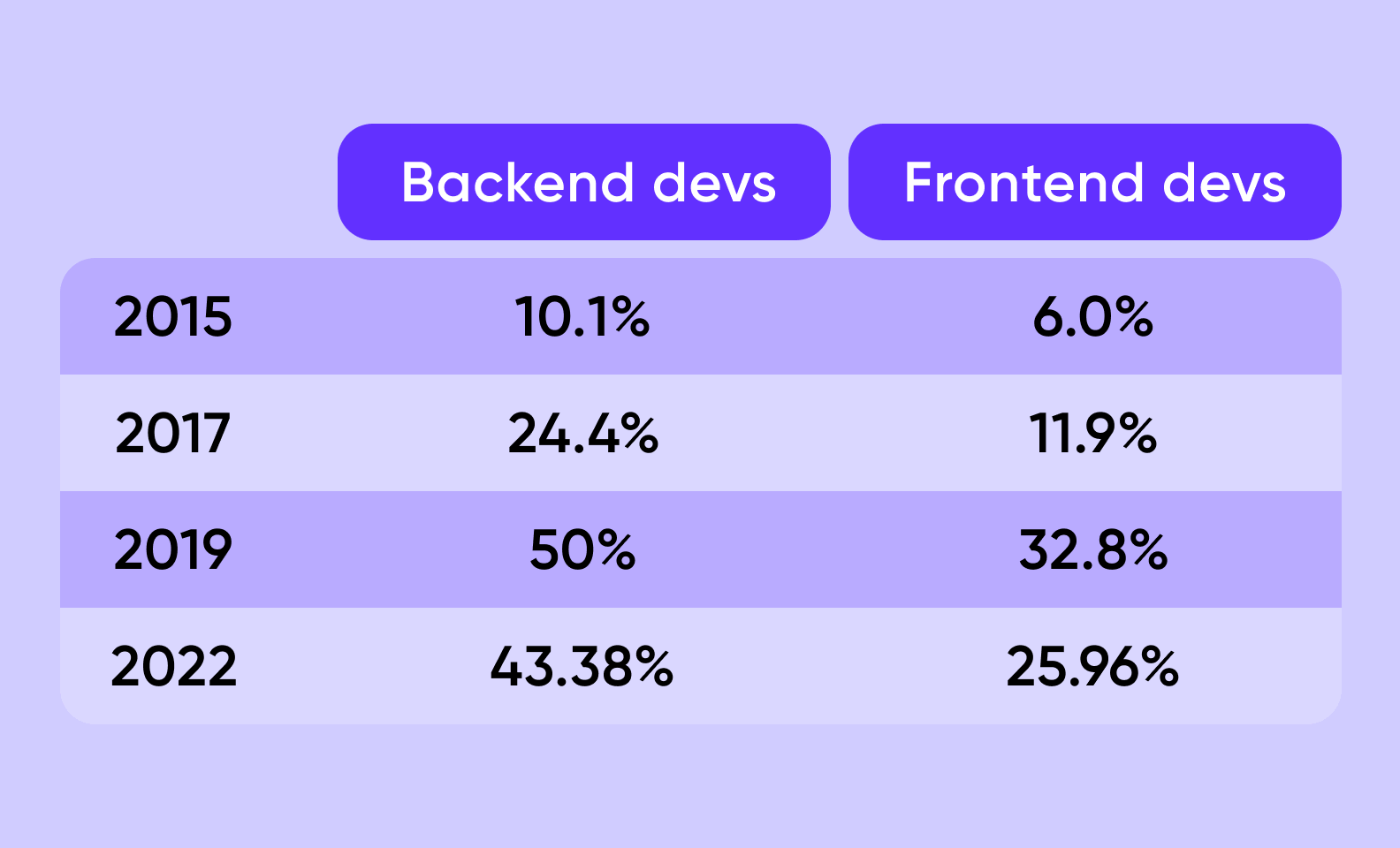
The percentage of backend and frontend developers from the total number of respondents according to Stack Overflow
QA engineers
Key duties: remove bugs and glitches. QA engineers or testers ensure the proper functioning of apps and detect bugs. They rely on technical documents and common sense, looking at the app from both users’ and developers’ perspectives. Testers verify the app’s performance and appearance, check databases and development processes, and compare them with the client’s needs.
Testing requires not only technical skills but also specific personal qualities. Here is a list of the most important skills:
App development stages
Being an app development company ourselves, we know what business owners need to do to launch an app. We use the MVP approach and we strongly recommend it. A minimal viable product is a basic version of the app that has minimal but sufficient functions to satisfy the first consumers. It helps to test the idea on the market without heavy expenses.
The mobile app development process consists of several stages.
Step 1. Do the market research
Who’s responsible: a founder
You need to conduct market research to make sure the app is competitive. No matter how extraordinary and cool your app idea may seem, there should be a demand on the market for it. You need to draft an app development project — identify your target audience, understand your competitors, and design a marketing strategy. This ensures that your app will be successful in the long run.
Step 2. Estimate the project and plan
Who’s responsible: business analysts
After you have identified the idea, analysts step in. Business analysts explore your case, look at how to bring your idea to life, and choose the appropriate tools. They create a plan and determine the main goal. At this stage, it is extremely important to identify the functions of your future app. Based on them, business analysts estimate the cost and timing of development. Look for essentials and don’t overload your product.
Step 3. Design
Who’s responsible: UI/UX designers
Developing an overall app idea is the first step, but when you’re done, it’s time to move on to the design. Find references that you like demonstrating how you want the app to look. Remember, seamless user experience and simplicity. If your app is convenient, the users will use it.
Step 4. Code
Who’s responsible: frontend and backend developers
At this stage, it’s time to turn design samples into a working app.
Typically, coders use React Native to speed up and simplify the whole app development process. Apps built on React Native share a codebase between the iOS and Android versions, with 65-70% of the same code — and that’s not the only advantage. This JavaScript framework reduces the number of bugs during development, makes maintenance easier in the future, and saves the time required for other activities like marketing analysis or monetization strategy development.
Step 5. Test your app
Who’s responsible: QA engineers
Quality Assurance is necessary to fix all bugs and errors that occur during software development. Testing helps ensure that the app works seamlessly on various operating systems and screen sizes, so users have a consistent experience across all devices. Moreover, testing helps identify security vulnerabilities, improve data protection, and check app performance.
Step 6. Release
Who’s responsible: project managers and developers
Among all the app development stages, the launch is the most highly anticipated. The thought-out and attention-grabbing release of the final version of an app is key. The project manager organizes the process and ensures the proper involvement of all parties needed.
Make your app available for download at major app marketplaces like Google Play or App Store. Then, watch how your client base grows.
Step 7. Collect feedback and iterate
After the release, it’s not over. Now you need to start collecting feedback from users to identify areas where the app can be improved. You may decide to add new features or improve existing ones, so you mey need the help of the team of mobile app developers again.
3 ways to find mobile app developers
There are 3 main approaches to hiring if you need employees who are ready to create a unique project for you. You can employ devs in-house, find a freelancer, or ask a full-cycle outsourced team. Let’s take a closer look.
In house team
Team members gather under one roof, which facilitates the process of communication and simplifies control. However, finding and hiring full-time app devs takes time and resources. It includes creating a job posting, reviewing CVs and portfolios, interviewing, and negotiating — usually it takes from two to six weeks, though this process can last months. You will also face the costs of office rent, medical insurance, sick leaves, vacations, and other expenditures.
Freelance
This is the first thing that comes to mind when you are looking for an alternative to in-house recruitment. The main attraction is the low cost. Expenses here are considered lower than the salary of full-time staff. Hiring freelance app developers may be a reasonable option for a startup with a limited budget, however, one freelancer is unlikely to cope with the task of developing an app. Mobile app development requires a flexible team of several experts.
Outsource
Companies engaged in the development of mobile apps on outsourcing are flexible full-cycle teams that include all the employees necessary to create an app: a project manager, a UI/UX designer, a QA engineer, a frontend, and a backend developer, and analysts. Adaptation is not required, as team members are used to working together. You can also avoid tedious supervision while maintaining full control over your project.
How to hire the right mobile app development team
Now you know who your perfect team members will be and what they will do. In this section, we’ll share some recommendations on hiring mobile app developers.
The No. 1 method is outsourcing, and here are some reasons for it.
-
- The cheapest way to hire is by choosing freelancers, the most expensive is in-house, but the happy medium in terms of price-quality ratio in software development is outsourcing.
- An outsourcing team is typically packed with professionals of the same level who already have communication and collaboration processes up and running, so you don’t need to build them from scratch.
- With outsourcing, a project manager helps establish fast and comfortable communication with the entire team.
Now let’s look at the hiring tips.
1. Analyze development costs
Estimate your budget for the whole project. Choose a range of prices that will be convenient for you and lay down some money for improvements, force majeure circumstances, and adding new functions.
2. Use different platforms to find specialists
Consider several options for finding and hiring specialists so that you have more choice and freedom. You can find developers on LinkedIn, freelancer platforms, outsourcing agencies, social networks, or use referrals and recommendations. Always check reviews of previous clients, when hiring an outsource team.
3. Choose the right collaboration model
Choose wisely between an in-house team, outsourced development, outstaffing or freelance. Based on your goals and needs, weight out all the pros and cons of different collaboration models. Consider the complexity and duration of your project, stack of technologies, budget limitations and risks involved.
4. Take your time when searching
Explore opportunities available to you, and choose the most experienced and trustworthy developers. Study their profiles and portfolios carefully, and contact them individually online, if possible.
5. Choose Agile methodology
Agile is a way to manage a project by dividing it into several phases to make the process iterative. This approach will save a lot of time and money, so it’s better to find a team that has worked with this methodology before.
6. Establish accessible communication
Look for simple, fast, and manageable communication, an absence of language barriers, and the ability to avoid time zone issues. Choose convenient communication channels and planners — a project manager can help here. Try not to hire developers if you’ve been waiting for their response for ages.
7. Consider your personal preferences
Check if you feel comfortable with the team, they understand your values and support your goals. If you value openness, try to find people for whom transparency is one of the most important working standards. At the interview, pay attention to how much developers are willing to share their experience, cases of success and failure. If you go for outsourcing, study the company’s website and blog to see whether the team is open with their potential customers.
How much does it cost to hire an app development team in 2024
Costs of the project will depend on a lot of factors but, first of all, on the collaboration model you choose. Here is a price breakdown for outsource and outstaff teams.
Outsourcing
If you partner with an outsourced app development team, you pay for the whole project. The cost of a project mostly depends on:
-
- The app’s complexity and innovation. A fully customized app with innovative features and design will cost you more than a basic one with standard UI.
- The hourly rate of a frontend and backend developer, a designer, a project manager, and other specialists. Working with a team of experienced professionals with a large portfolio increases the development cost.
Here’s the approximate pricing if you cooperate with Purrweb.
-
- Simple app — $30,000
- Medium complexity app — $50,000
- Complex app — $80,000
Outstaffing
If you decide to outstaff the development, you can customize your own team, diversify tech stack and hire only specialists with specific skills. For example an Android developer, to help the team convert an iOS app into an Android solution or a product manager, to supervise a pet project with a quick turnaround.
Here is an approximate hourly rates of different specialists at Purrweb:
| Specialist | Hourly rate | Monthly rate |
| Node.js developer | from $40 | from $6 600 |
| React.js developer | from $40 | from $6 600 |
| React Native developer | from $40 | from $6 600 |
| UI UX designer | from $37 | from $6 150 |
| QA engineer | from $17 | from $2 805 |
| Project manager | from $30 | from $4 950 |
A tip from our team: If you choose outstaffing services for long-term projects (over 6 months) you can usually get discounted rates.
How to manage an app development team: 3 tips
Quality collaborations require a blend of visionary leadership, open communication, and effective project management.
Here are 3 tips from the Purrweb team on how to ensure a smooth and productive workflow:
Define and communicate expectations
First of all clearly define and communicate expectations to your mobile app development team. This involves setting realistic goals, outlining project milestones, defining development team roles and establishing a clear vision for the final product.
Ensure that team members understand their responsibilities, and the overall objectives of the project. Regularly check in with the team to address any concerns, clarify confusions, and provide constructive feedback.
Encourage retrospectives
These meetings are your chance to check in with the mobile app development team and discuss the progress at the end of each sprint. Retrospectives provide a valuable opportunity for the dedicated team to reflect on what worked well, what could be changed, and how to implement those improvements moving forward.
A key is to create a positive and welcoming environment where team members feel comfortable to share their thoughts and feedback.
Use the insights gained from retrospectives to refine processes, address challenges, and enhance overall team performance.
Use project management software
Project management software is a crucial tool to keep your Android or iOS developer, product manager and UI/UX designer organized and on track. Platforms like Jira, Trello, ClickUp or Asana can help streamline tasks, manage deadlines, and facilitate collaboration.
Break down the project into manageable sprints, assign tasks, and track progress in real-time. This approach not only enhances efficiency but also provides transparency, and allows team members to check on what others are working on.
At Purrweb, we use Jira and ClickUp to manage workload in our team and make sure tasks are completed on time.
Summing up
The right app development team structure is key to success. When each team member fulfills their duties, goes towards a common goal, and communicates with other members, the mobile app development process can be better coordinated, changed, and improved. When creating a product, this approach will be ideal.
With our 8 years of MVP development experience, we have seen many cases of varying complexity and created 300+ projects. Usually, an app development team at Purrweb includes 6 people: 1 project manager, 2 UI/UX designers, 2 developers, and 1 QA engineer.
Check out our portfolio to learn more about our experience. If you want to request a project development, write to us in the form below.


